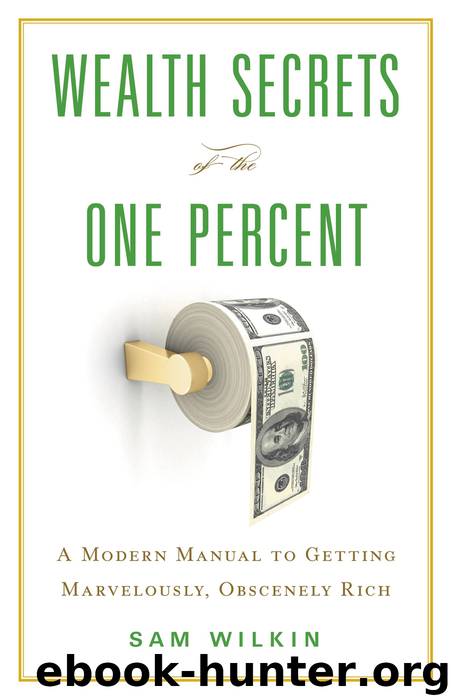Wealth Secrets of the One Percent by Sam Wilkin

Author:Sam Wilkin [Wilkin, Sam]
Language: eng
Format: epub
Tags: Business & Economics / Personal Finance / Investing, Business & Economics / Personal Finance / Money Management, Business & Economics / Motivational, Business & Economics / Personal Finance / General, Business & Economics / Personal Success
Publisher: Little, Brown and Company
Published: 2015-08-04T04:00:00+00:00
GAME ON!
In the wake of the global financial crisis, Wall Street expressed some contrition (while attempting, awkwardly, to cover up its naughty bits). JPMorgan Chase rebranded its investment banking arm as “J.P. Morgan” partly in an effort to emphasize its long history. The invitations to the bank’s rather subdued annual party at the World Economic Forum meetings in Davos included a reproduction of Pierpont Morgan’s signature. I am not sure, however, that Pierpont Morgan would have approved of his bank’s modern wealth secret, which involved playing a game that was fundamentally out of control. This was dramatized by Chuck Prince, the CEO of Citigroup, who in the summer of 2007 famously proclaimed: “As long as the music is playing, you’ve got to get up and dance.” As long as the good times were rolling, Prince felt obligated to play along. I doubt Pierpont Morgan would have shared this sentiment. At such a dance, he likely would have been found conducting the orchestra, not waltzing to someone else’s tune. Moreover, all that scheming and innovating and risk taking probably involved too much hard work for Morgan’s taste.
J.P. Morgan (the modern bank) also took the precaution of adding Al Gore and Tony Blair to the payroll as advisors, perhaps with one eye on the rising political backlash against banks. Other than that, not much changed in the years immediately following the crisis. The moneyed herd in 2014 could still be found whiling away the hours in pop-up strip clubs in midtown Manhattan. U.S. banks in 2013 had, after all, enjoyed their best year for profitability since before the financial crisis. The 2013 banking bonus pool of $26.7 billion for New York banks—an average of $164,000 per employee—was the largest the city had seen since 2007. Too big to fail was still very much in evidence, and it was still paying the gamblers over the odds.
Indeed, during the global financial crisis, smaller banks had engaged in a frenetic wave of mergers, apparently in an effort to achieve too-big-to-fail status. The most dramatic such attempt was the acquisition of Wachovia by Wells Fargo. At the time, Wachovia was collapsing. Hence the Federal Reserve arranged for Citigroup to take it over with some taxpayer support. This deal was announced on October 29. Only a few days later, however, Wells Fargo had swooped in and managed, in effect, to outbid the U.S. government, offering a better deal to Wachovia’s owners, apparently in a brilliant (and successful) effort to become too big to fail. This was the first time anyone had outbid the FDIC, but the basic strategy was by no means unprecedented. Even before the crisis, banks were eager to become too big to fail. One study calculated that between 1991 and 2004, U.S. banks had paid an aggregate premium of $15 billion for acquisitions that would take them above the too-big-to-fail threshold.
Of course, there has been a regulatory backlash in the wake of the crisis. The Dodd-Frank Wall Street Reform and Consumer Protection Act of 2010 included an orderly liquidation process for failing banks.
Download
This site does not store any files on its server. We only index and link to content provided by other sites. Please contact the content providers to delete copyright contents if any and email us, we'll remove relevant links or contents immediately.
| Analysis & Strategy | Bonds |
| Commodities | Derivatives |
| Futures | Introduction |
| Mutual Funds | Online Trading |
| Options | Portfolio Management |
| Real Estate | Stocks |
Pioneering Portfolio Management by David F. Swensen(5733)
Rich Dad Poor Dad by Robert T. Kiyosaki(5385)
How To Win Friends and Influence People by Dale Carnegie(3943)
The Money Culture by Michael Lewis(3423)
The Dhandho Investor by Mohnish Pabrai(3258)
The Wisdom of Finance by Mihir Desai(3187)
Liar's Poker by Michael Lewis(2935)
The Intelligent Investor by Benjamin Graham Jason Zweig(2673)
The ONE Thing by Gary Keller(2624)
Mastering Bitcoin: Programming the Open Blockchain by Andreas M. Antonopoulos(2613)
How to Day Trade for a Living: Tools, Tactics, Money Management, Discipline and Trading Psychology by Andrew Aziz(2552)
Investing For Dummies by Eric Tyson(2551)
Fooled by Randomness: The Hidden Role of Chance in Life and in the Markets by Nassim Nicholas Taleb(2539)
How to Win Friends and Influence People by Dale Carnegie(2535)
Rich Dad Poor Dad: What The Rich Teach Their Kids About Money - That The Poor And Middle Class Do Not! by Robert T. Kiyosaki(2503)
Zero Hour by Harry S. Dent Jr. & Andrew Pancholi(2309)
Market Wizards by Jack D. Schwager(2252)
How to Pay Zero Taxes, 2018 by Jeff A. Schnepper(2207)
Rich Dad's Guide to Investing by Robert T. Kiyosaki(2186)
